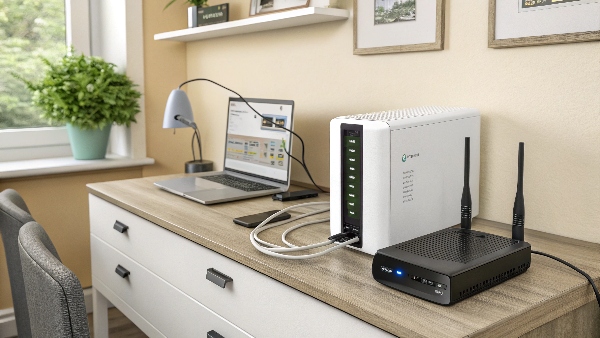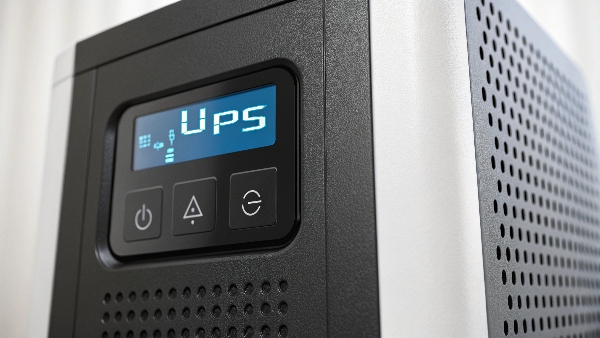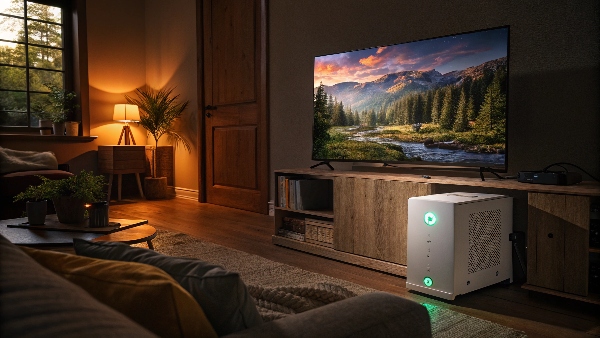Your internet suddenly drops during a crucial video call or while streaming your favorite show. Annoying, right? A UPS prevents this network downtime, keeping your vital connection stable during power flickers or outages.
The best UPS for a home network typically has a capacity of 600VA to 1500VA. This size provides enough runtime for your modem, router, and possibly a Network Attached Storage (NAS). Line-interactive models with Automatic Voltage Regulation (AVR) offer good protection against common power fluctuations.

Choosing the right UPS for your home network can seem a bit daunting with all the technical terms and options out there. I've been in the power solutions business for 10 years, and even I can see how it might be confusing for home users! But understanding a few key aspects makes it much simpler. As we've seen UPS systems become increasingly popular for home use, just like for our larger clients in healthcare and data centers, their role in maintaining daily connectivity is clear. Let's explore what makes a UPS suitable for protecting your digital lifeline at home, so you can make an informed choice.
What size UPS do I need to power my house?
Powering your entire house with a UPS sounds like the ultimate solution, but it's a much bigger and more complex undertaking. Confused about the scale? Most people just need to protect key devices, not everything.
Powering an entire house typically requires a very large UPS (5kVA to 10kVA+, or even more), often integrated with a backup generator. For just a home network (modem, router), a much smaller UPS (usually 600VA-1500VA) is sufficient, more affordable, and far more practical for most homeowners.

When we talk about a UPS for a "home network," we're generally referring to a compact unit designed to keep your internet connection (modem, router) and maybe a few other small devices like a NAS or a smart home hub running. This is very different from a "whole-house UPS." A whole-house system is a major installation, requiring professional electricians. It involves a large, powerful UPS, a significant bank of batteries, and often integration with your home's main electrical panel. The cost and complexity put it out of reach or necessity for most homeowners. In my experience as an OEM/ODM manufacturer, these larger systems are more akin to what we supply for small businesses or critical infrastructure projects.
For your home network, the calculation is much simpler. You need to identify the devices essential for your internet connectivity.
- Modem: This device connects you to your internet service provider.
- Router1: This shares the internet connection with your devices via Wi-Fi or Ethernet.
- Network Switch (if you use one): For expanding wired connections.
- Network Attached Storage (NAS)2 (optional): If you have a home server for files or media.
Look at the power adapter or the label on each device. It will usually list the power consumption in Watts (W) or Amps (A) and Volts (V). If it's in Amps, Watts = Volts x Amps. Sum up the wattage for all devices you want to protect. For example, a modem might use 10W, and a router 10W, totaling 20W. UPS systems are rated in Volt-Amps (VA) and Watts. Due to "power factor" (a technical detail), the Watt rating is usually lower than the VA rating (e.g., a 600VA UPS might be 360W). Always ensure the UPS's Watt rating exceeds your total load. For a typical home network, a 600VA to 850VA unit is often plenty.
| Network Device | Typical Watts | Suggested UPS (Network Only) |
|---|---|---|
| Cable/DSL Modem | 5-15W | Part of total calculation |
| Wi-Fi Router | 5-20W | Part of total calculation |
| Combined Total | 10-35W | 600VA - 1000VA |
How long will a UPS power supply last?
The power is out, and your UPS has kicked in. But for how long will it keep your network alive? This uncertainty can be stressful when you're trying to finish work or just stay connected.
UPS runtime without power depends mainly on its battery's capacity (measured in Ampere-hours or Volt-Amps-hours) and the total power draw (load in Watts) of the connected devices. For a typical home network, a 600-1000VA UPS might provide 15 to 60 minutes, or even more, of power.

The duration your UPS can keep things running during an outage, known as its "runtime," is a key factor. It's not a fixed number; it's a dynamic value. The primary determinant is the battery capacity. Think of it like the fuel tank in your car – a bigger tank (higher Ah or VAh rating) generally means you can go further. The second major factor is the load – how much power your connected devices are drawing. A modem and router typically sip power, maybe 10-25 Watts combined. With such a low load, even a modest UPS, say 650VA / 360W, can provide a surprisingly long runtime, often 30 minutes to over an hour. I remember a client who was surprised his small UPS kept his internet up for nearly 90 minutes during a local outage, just for his modem and router!
Battery health and age also play a crucial role. A brand-new battery will perform at its peak, but as it ages (typically 3-5 years for standard VRLA lead-acid batteries), its ability to hold a charge diminishes. So, a 3-year-old battery won't give you the same runtime it did when new. This is why we always emphasize the importance of periodic battery checks, something our advanced UPS systems often facilitate. We also offer lithium battery UPS solutions, which tend to have a longer lifespan and can maintain performance better over time. While external battery modules (EBMs) are an option to greatly extend runtime, they are generally overkill for just a home network unless you have very specific, extended uptime needs. For most home users, the goal is to outlast short flickers or have enough time to save work if it's a longer outage.
Can an UPS power a TV?
A blackout hits right in the middle of your movie night or the big game. Can your UPS save the show and keep the TV on? Not all UPS units are created equal for powering entertainment systems, which can be quite power-hungry.
Yes, a UPS can power a TV. However, TVs, especially larger smart TVs, can draw significant power (80W to 200W+). You'll likely need a larger UPS (e.g., 1000VA-1500VA or more) to get a reasonable runtime. Always check your TV's specific wattage.

While the primary goal for a home network UPS is to keep your internet connection alive, you might wonder about other devices, like your television. The answer is yes, a UPS can power a TV, but you need to be realistic about the power requirements. A modern 55-inch LED or OLED smart TV can consume anywhere from 80 Watts to over 150 Watts, depending on brightness and content. Add a soundbar (another 20-50W) and a streaming box or game console (5W to 200W+ for a console), and the load quickly adds up.
A small UPS that's perfect for your 20W modem/router setup will struggle and offer very little runtime for a 150W TV setup – perhaps only a few minutes, if it can even handle the initial power-on surge. If keeping your TV on during an outage is important, you'll need to size the UPS accordingly. You'd likely be looking at a unit in the 1000VA to 1500VA (600W to 900W) range, or even larger for more extensive home theater systems or longer runtimes. One thing I always advise our clients, whether they are procurement managers for large facilities or individuals, is to check the power label on the back of their devices. It's the most accurate way to know the wattage. Also, consider if a pure sine wave output UPS is needed. Most modern TVs use switch-mode power supplies that are tolerant of simulated sine wave output (common in budget-friendly line-interactive UPSs), but sensitive audio equipment or some high-end TVs might prefer pure sine wave, which our more advanced units provide.
| Device Example | Approx. Watts | UPS VA Suggestion (for ~15-30 min runtime) |
|---|---|---|
| Modem + Router | 15-30W | 600VA - 850VA |
| 55" Smart LED TV | 80-120W | 1000VA - 1500VA |
| TV + Soundbar + Streamer | 100-180W | 1500VA |
| Gaming PC + Monitor | 300-600W+ | 1500VA+ (often needs Pure Sine Wave) |
What to consider when buying an UPS?
Choosing a UPS can feel complex with all the specifications and features listed. Make the wrong choice, and you might not get the protection or runtime you truly need for your home network.
Key considerations when buying a UPS include its capacity (VA/Watts matched to your load), required runtime, the number and type of outlets, form factor, and essential features like Automatic Voltage Regulation (AVR), an LCD screen for status, and potentially USB connectivity for monitoring. A line-interactive type is often the best balance for home networks.

Buying a UPS doesn't have to be a headache. Based on my 10 years of experience designing and manufacturing these systems, here are the crucial things I tell people to look for, especially for a home network:
- Capacity (VA and Watts): First, calculate the total wattage of your modem, router, and any other device you want on battery backup. Choose a UPS with a Watt rating at least 20-25% higher than your total load to give it some headroom.
- Runtime: How long do you need your network to stay up during an outage? For short flickers, 10-15 minutes is fine. If you experience longer outages, aim for 30-60 minutes or more. Most manufacturers provide runtime charts.
- Number and Type of Outlets: Look for enough outlets for all your devices. UPS units usually have two types: "Battery Backup + Surge Protection" (for critical devices like modem/router) and "Surge Protection Only" (for non-critical peripherals like a printer). Ensure spacing allows for bulky power adapters.
- UPS Topology:
- Standby (or Offline): The most basic and cheapest. Passes AC power through and switches to battery during an outage. Minimal power conditioning.
- Line-Interactive: My usual recommendation for home networks. It includes an Automatic Voltage Regulation (AVR) transformer that corrects minor sags and swells without using the battery, which prolongs battery life. This is a great balance of protection and cost.
- Online (Double-Conversion): Provides the highest level of protection by constantly regenerating power. It's generally overkill and more expensive for typical home network needs but is the standard for critical applications we serve in data centers and hospitals.
- Waveform Output (when on battery):
- Simulated Sine Wave: Less expensive. Fine for most electronics with modern switch-mode power supplies, including modems, routers, and most computers.
- Pure Sine Wave: Cleaner power, identical to or better than utility power. Recommended for sensitive electronics, audio/video equipment, and computers with Active PFC power supplies.
- Features:
- LCD Display: Shows input/output voltage, load level, battery charge, estimated runtime. Very useful!
- USB/Serial Port: Allows the UPS to communicate with a connected computer for automatic shutdown software (less critical for just a modem/router, but good if a PC/NAS is connected).
- Data Line Surge Protection: Ports (RJ45 for Ethernet, RJ11 for phone, Coax) to protect against surges coming through data lines.
- User-Replaceable Batteries: Saves money and hassle when the battery eventually wears out.
- Audible Alarms: Alerts you to power changes or low battery.
- Brand Reputation and Warranty: Choose a reputable manufacturer. As a company committed to quality (backed by CE, RoHS, and ISO certifications), we know the importance of reliability and good support. A decent warranty (2-3 years on the UPS, 1-2 years on the battery) is a good sign.
Thinking through these points will help you select a UPS that truly meets your home network's needs.
Conclusion
Selecting the right UPS is key to keeping your home network online during power outages. Carefully consider your connected devices' load, your desired runtime, and the essential features for reliable, uninterrupted connectivity at home.

